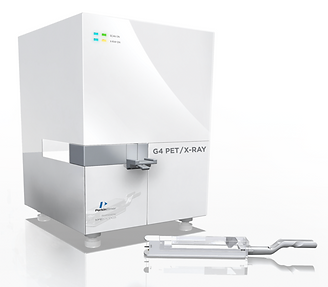Holland Lab
Medicinal Radiochemistry
Our group operates a total radiotracer development program from novel radiochemistry through to full preclinical imaging and clinical translation
'A world first in chemistry and imaging science ...
... our unique ChemPET facility features complete radiotracer development, housed in a pure chemistry department'

PRECLINICAL MOLECULAR IMAGING
Our imaging studies provide full biochemical evaluation of the distribution and specificity of our new radiotracers in vivo using a positron emission tomography (PET).
Our labs operate the market-leading G4 PET/X-ray camera from Sofie Biosciences. The G4 combines excellent image resolution with the highest sensitivity (14%) in one of the world's most compact, bench-top, small-animal imaging cameras.
Better imaging improves science.
sofie biosciences
g4 pet/x-ray
Biodistribution analysis
Developing new imaging agents that provide specific information on the biochemistry of disease requires detail knowledge of the distribution in vivo.
We use highly accurate gamma counting tools to provide quantitative determination of radiotracer distribution in tissue samples ex vivo.
The Hidex Automatic Gamma Counter combines rapid throughput and extremely high sensitivity with the convenience of automatic sample measurements. This market-leading technology incorporates a convenient balance for automatic sample weighing.

Hidex
Automatic gamma counter

Hidex Sense
Plate-reader
in vitro characterisation
Extensive chemical and biochemical characterisation in vitro is required for new imaging agents before they are evaluated in vivo.
Our experiments encompass stability assays using chemical and biochemical challenges, metabolite analysis, as well as a full range of cellular-based assays to measure radiotracer affinity, specificity and intracellular localisation.
The Hidex Sense plate reader combines extreme sensitivity and full automation with a user-friendly interface that facilitates rapid data acquisition for all plate-based UV/visible absorption and fluorescence-emission measurements in vitro.
From the lab to the clinic
The benefits of molecular imaging lie in our ability to transfer promising preclinical science into useful clinical tools.
Our lab operates a fully approved preclinical experimentation facility for assessing new PET radiotracer performance using the latest models of human disease in vivo.
We work closely with physicians at the University Hospital Zurich (USZ), and beyond, to ensure rapid and smooth translation of our imaging agents from the lab to the clinic.

Complete preclinical testing
& translation
Prospective clients and Collaborators
Are you interested in using imaging science to advance your research? Contact us to discuss the benefits and possibilities.

